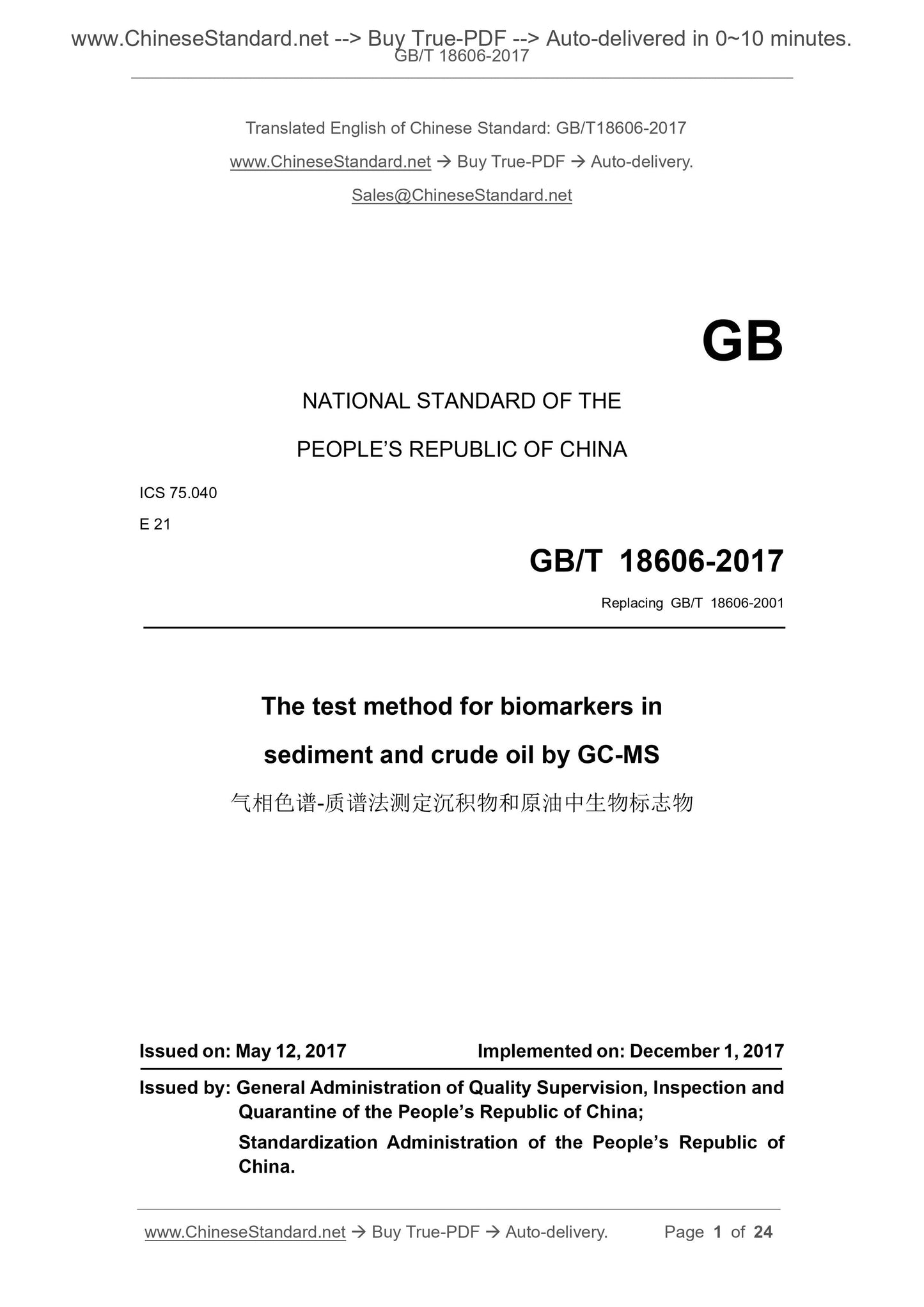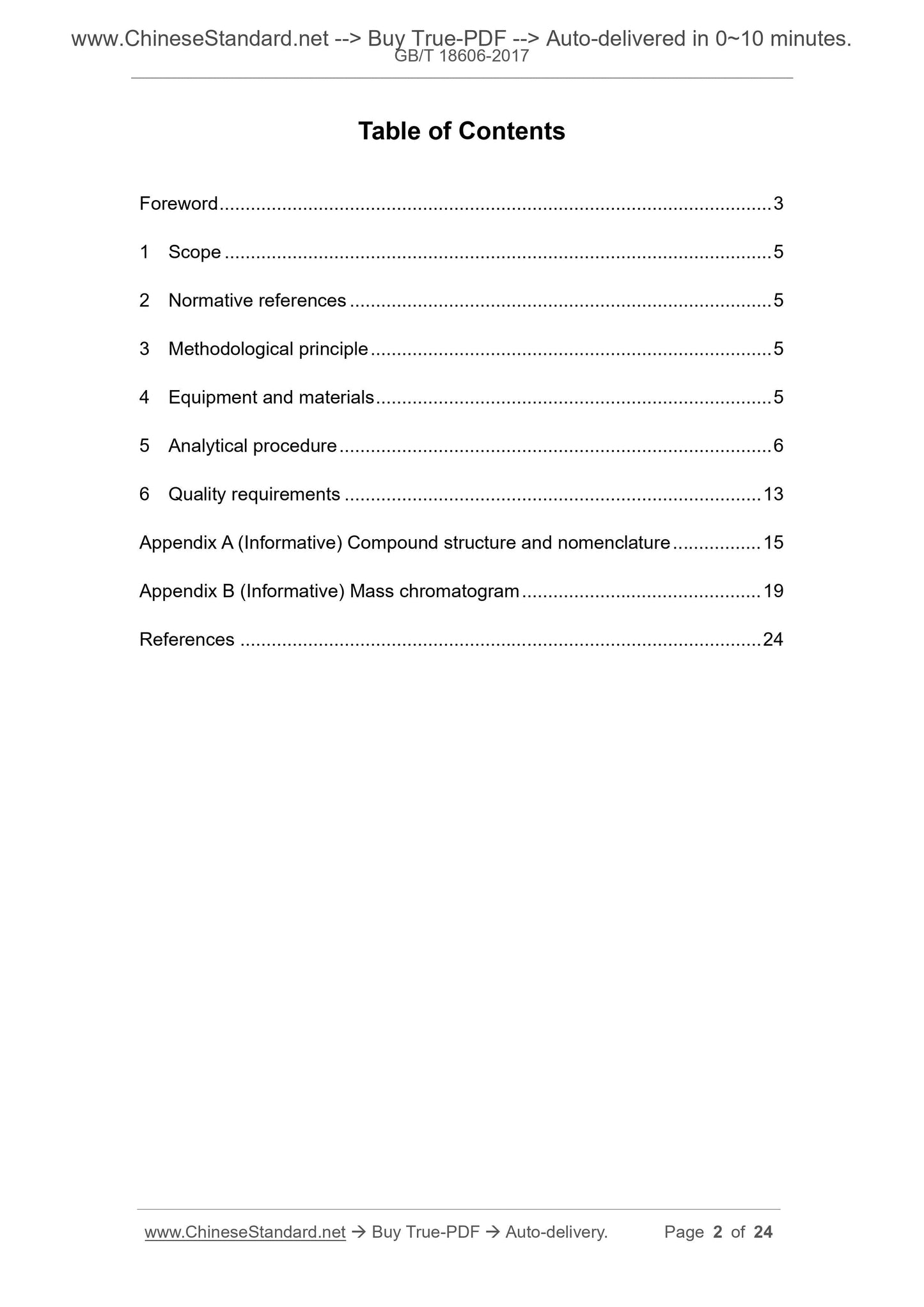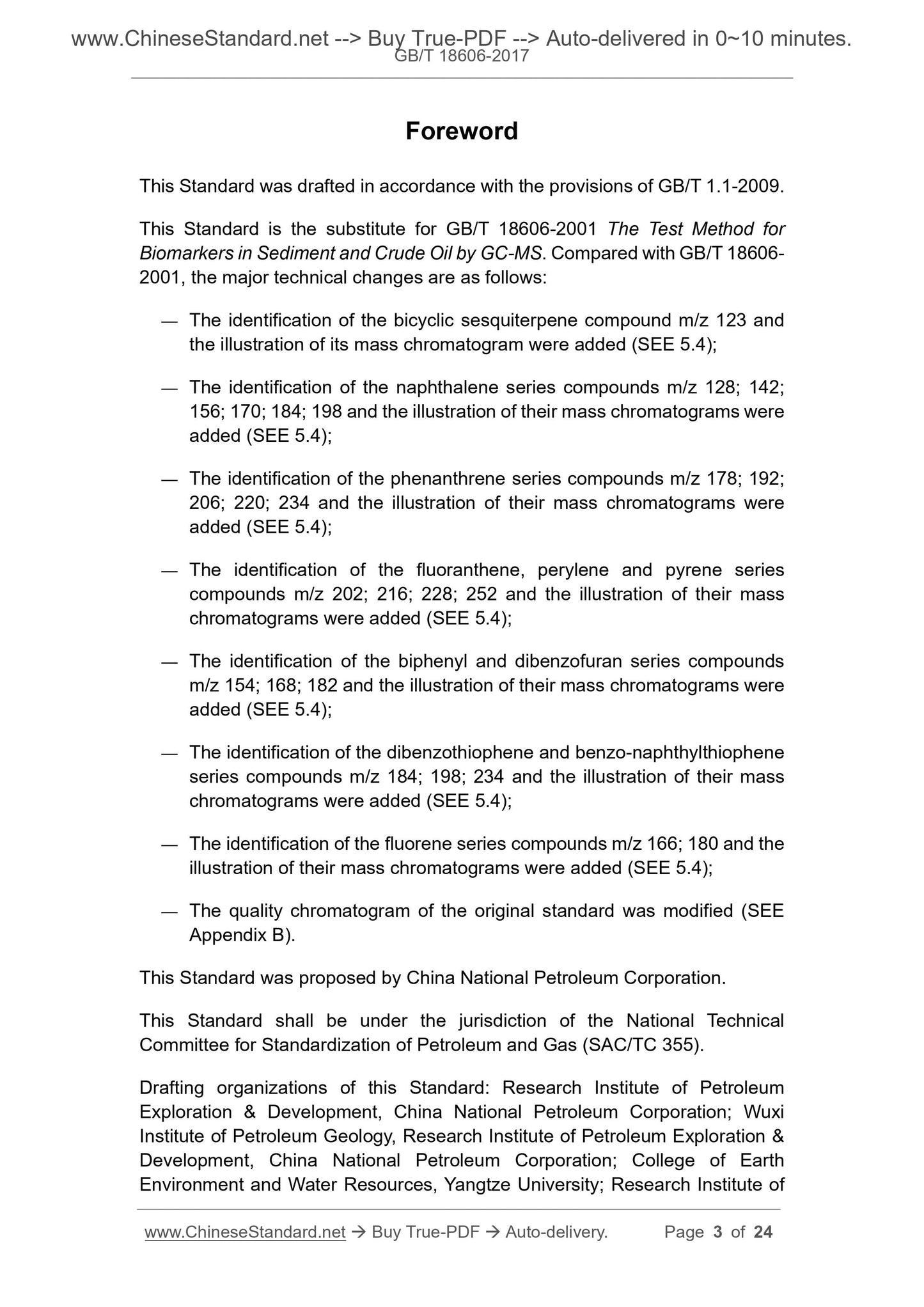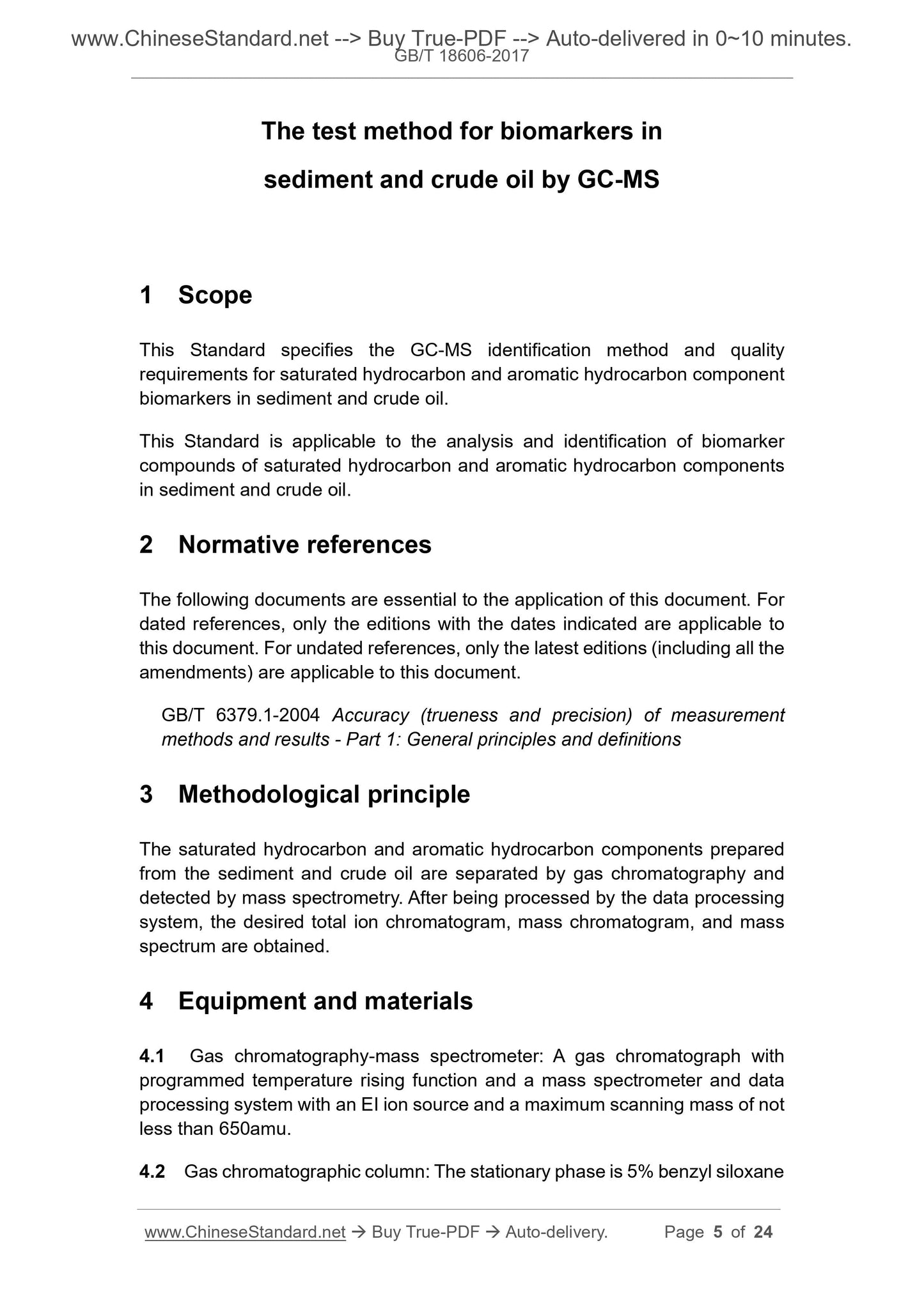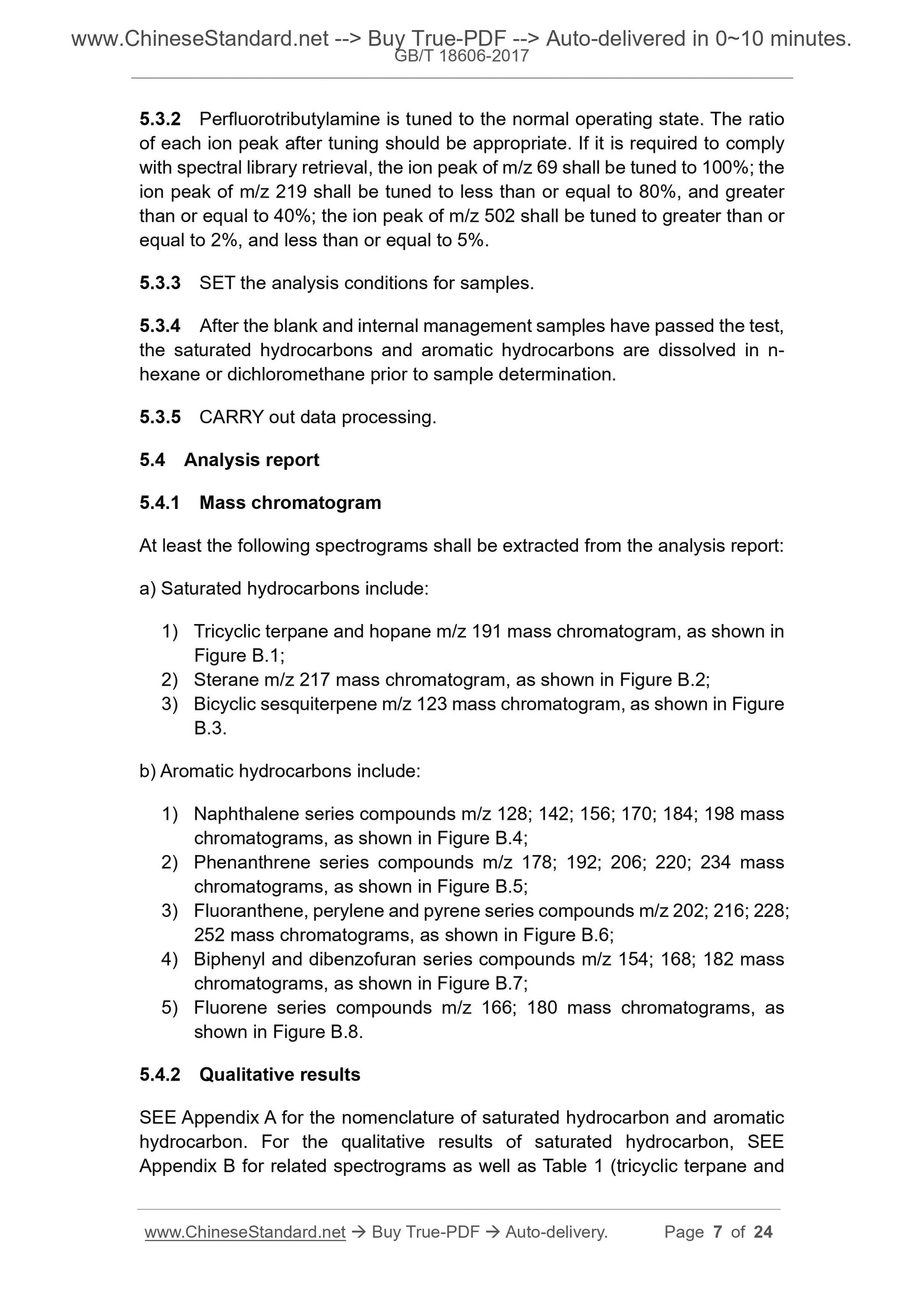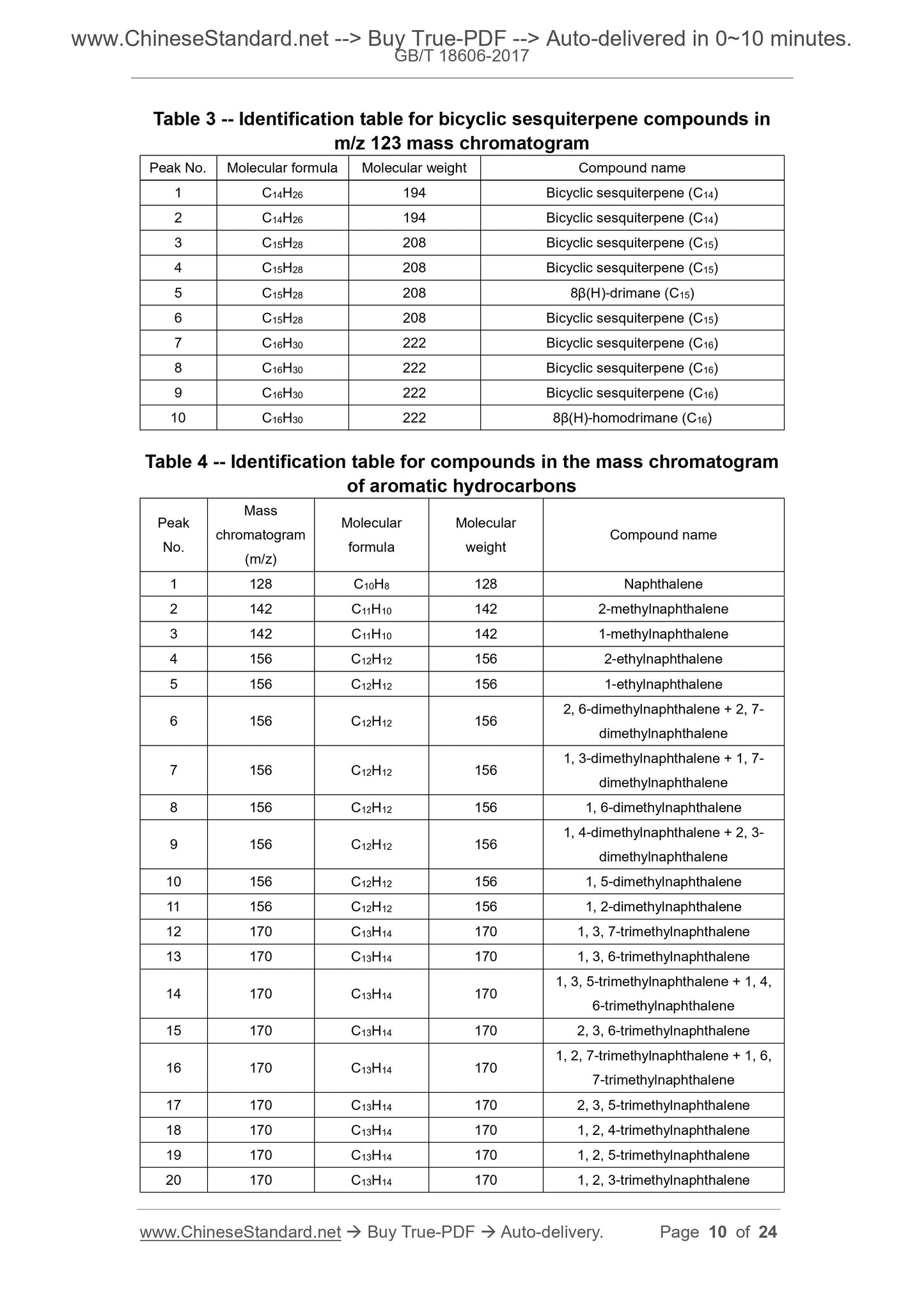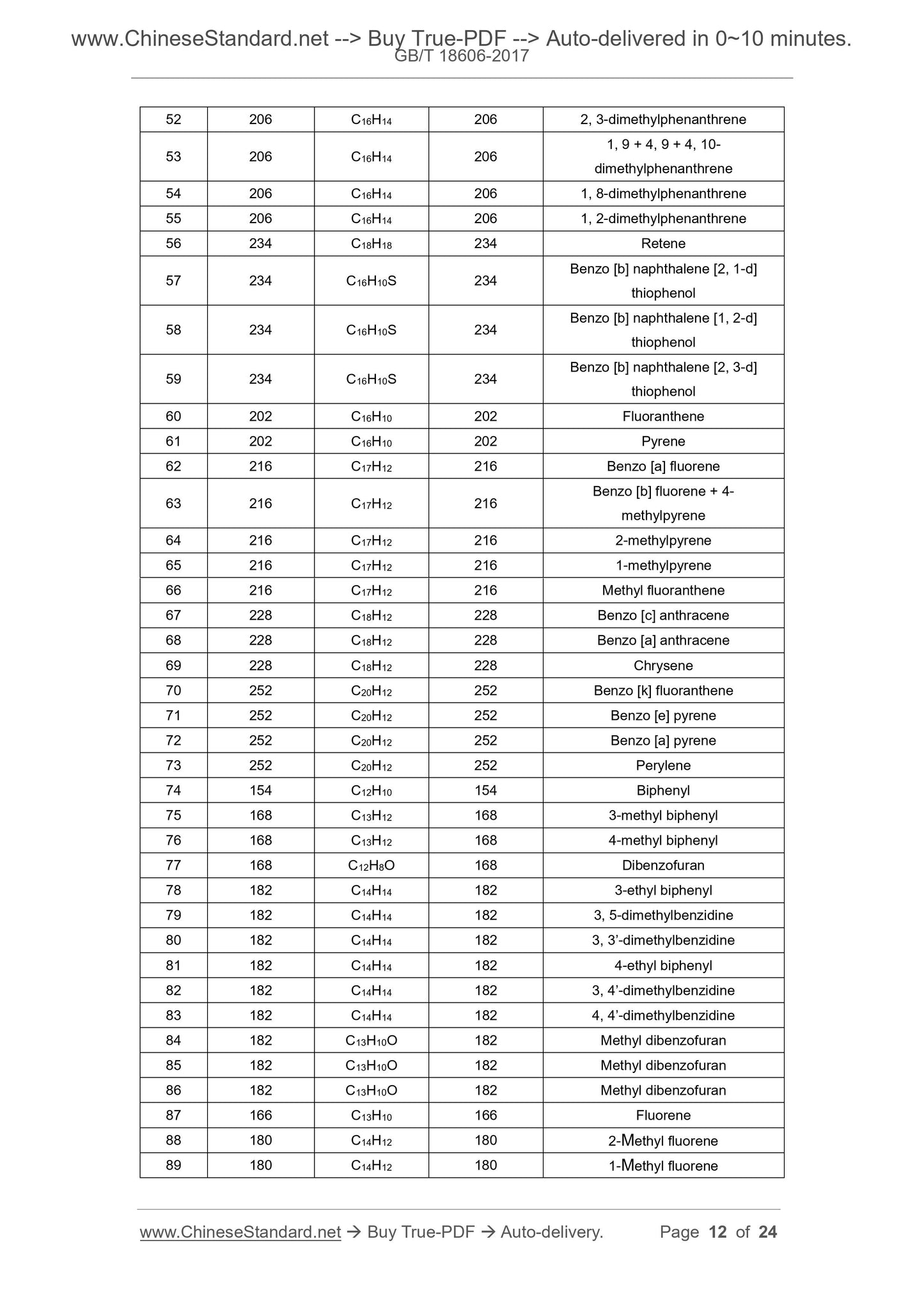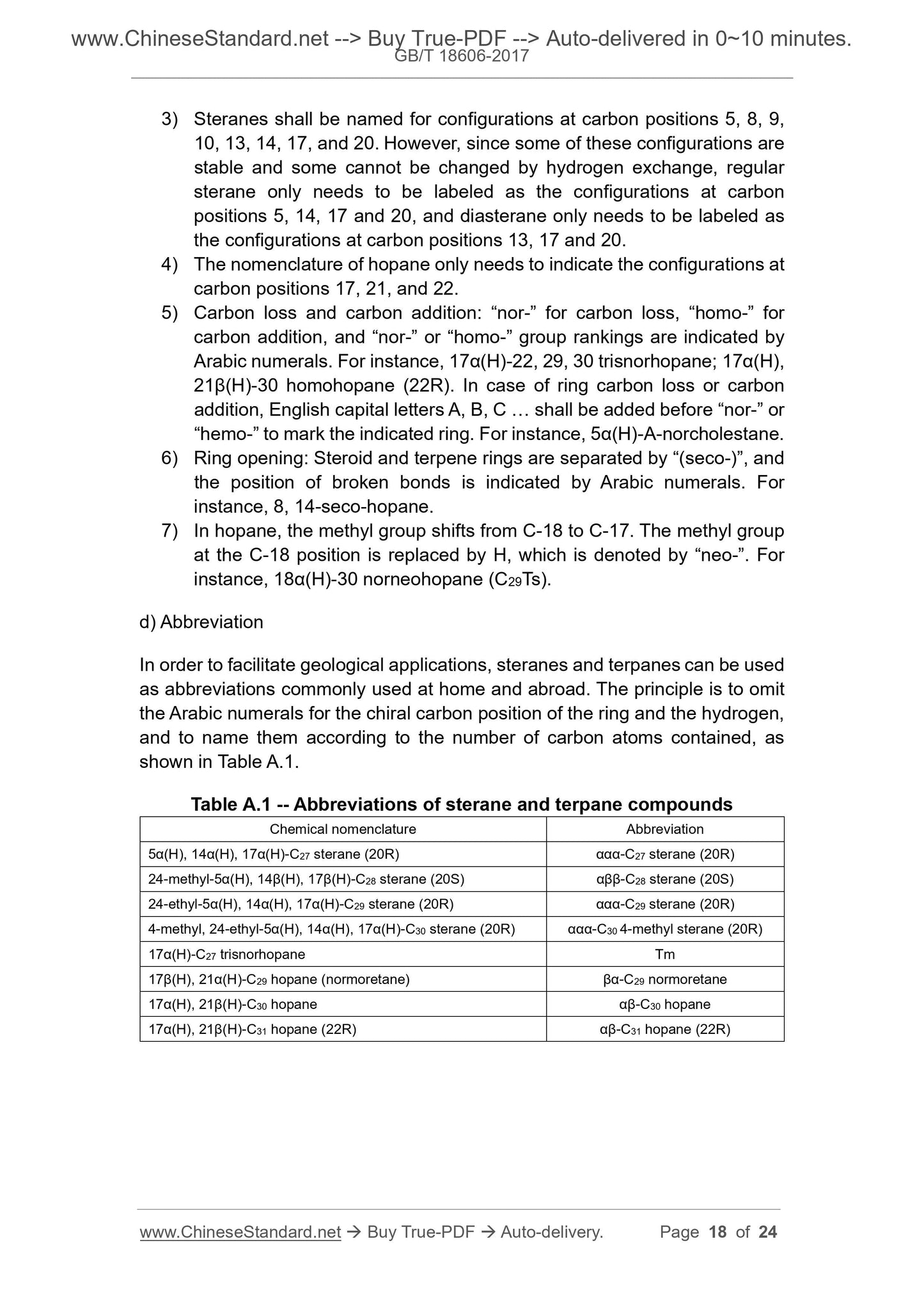1
/
von
8
PayPal, credit cards. Download editable-PDF & invoice In 1 second!
GB/T 18606-2017 English PDF (GBT18606-2017)
GB/T 18606-2017 English PDF (GBT18606-2017)
Normaler Preis
$230.00 USD
Normaler Preis
Verkaufspreis
$230.00 USD
Grundpreis
/
pro
Versand wird beim Checkout berechnet
Verfügbarkeit für Abholungen konnte nicht geladen werden
Delivery: 3 seconds. Download true-PDF + Invoice.
Get QUOTATION in 1-minute: Click GB/T 18606-2017
Historical versions: GB/T 18606-2017
Preview True-PDF (Reload/Scroll if blank)
GB/T 18606-2017: The test method for biomarkers in sediment and crude oil by GC-MS
GB/T 18606-2017
GB
NATIONAL STANDARD OF THE
PEOPLE’S REPUBLIC OF CHINA
ICS 75.040
E 21
Replacing GB/T 18606-2001
The test method for biomarkers in
sediment and crude oil by GC-MS
ISSUED ON. MAY 12, 2017
IMPLEMENTED ON. DECEMBER 1, 2017
Issued by. General Administration of Quality Supervision, Inspection and
Quarantine of the People’s Republic of China;
Standardization Administration of the People’s Republic of
China.
Table of Contents
Foreword ... 3
1 Scope ... 5
2 Normative references ... 5
3 Methodological principle ... 5
4 Equipment and materials ... 5
5 Analytical procedure ... 6
6 Quality requirements ... 13
Appendix A (Informative) Compound structure and nomenclature ... 15
Appendix B (Informative) Mass chromatogram ... 19
References ... 24
Foreword
This Standard was drafted in accordance with the provisions of GB/T 1.1-2009.
This Standard is the substitute for GB/T 18606-2001 The Test Method for
Biomarkers in Sediment and Crude Oil by GC-MS. Compared with GB/T 18606-
2001, the major technical changes are as follows.
— The identification of the bicyclic sesquiterpene compound m/z 123 and
the illustration of its mass chromatogram were added (SEE 5.4);
— The identification of the naphthalene series compounds m/z 128; 142;
156; 170; 184; 198 and the illustration of their mass chromatograms were
added (SEE 5.4);
— The identification of the phenanthrene series compounds m/z 178; 192;
206; 220; 234 and the illustration of their mass chromatograms were
added (SEE 5.4);
— The identification of the fluoranthene, perylene and pyrene series
compounds m/z 202; 216; 228; 252 and the illustration of their mass
chromatograms were added (SEE 5.4);
— The identification of the biphenyl and dibenzofuran series compounds
m/z 154; 168; 182 and the illustration of their mass chromatograms were
added (SEE 5.4);
— The identification of the dibenzothiophene and benzo-naphthylthiophene
series compounds m/z 184; 198; 234 and the illustration of their mass
chromatograms were added (SEE 5.4);
— The identification of the fluorene series compounds m/z 166; 180 and the
illustration of their mass chromatograms were added (SEE 5.4);
— The quality chromatogram of the original standard was modified (SEE
Appendix B).
This Standard was proposed by China National Petroleum Corporation.
This Standard shall be under the jurisdiction of the National Technical
Committee for Standardization of Petroleum and Gas (SAC/TC 355).
Drafting organizations of this Standard. Research Institute of Petroleum
Exploration and Development, China National Petroleum Corporation; Wuxi
Institute of Petroleum Geology, Research Institute of Petroleum Exploration and
Development, China National Petroleum Corporation; College of Earth
Environment and Water Resources, Yangtze University; Research Institute of
The test method for biomarkers in
sediment and crude oil by GC-MS
1 Scope
This Standard specifies the GC-MS identification method and quality
requirements for saturated hydrocarbon and aromatic hydrocarbon component
biomarkers in sediment and crude oil.
This Standard is applicable to the analysis and identification of biomarker
compounds of saturated hydrocarbon and aromatic hydrocarbon components
in sediment and crude oil.
2 Normative references
The following documents are essential to the application of this document. For
dated references, only the editions with the dates indicated are applicable to
this document. For undated references, only the latest editions (including all the
amendments) are applicable to this document.
GB/T 6379.1-2004 Accuracy (trueness and precision) of measurement
methods and results - Part 1. General principles and definitions
3 Methodological principle
The saturated hydrocarbon and aromatic hydrocarbon components prepared
from the sediment and crude oil are separated by gas chromatography and
detected by mass spectrometry. After being processed by the data processing
system, the desired total ion chromatogram, mass chromatogram, and mass
spectrum are obtained.
4 Equipment and materials
4.1 Gas chromatography-mass spectrometer. A gas chromatograph with
programmed temperature rising function and a mass spectrometer and data
processing system with an EI ion source and a maximum scanning mass of not
less than 650amu.
4.2 Gas chromatographic column. The stationary phase is 5% benzyl siloxane
5.3.2 Perfluorotributylamine is tuned to the normal operating state. The ratio
of each ion peak after tuning should be appropriate. If it is required to comply
with spectral library retrieval, the ion peak of m/z 69 shall be tuned to 100%; the
ion peak of m/z 219 shall be tuned to less than or equal to 80%, and greater
than or equal to 40%; the ion peak of m/z 502 shall be tuned to greater than or
equal to 2%, and less than or equal to 5%.
5.3.3 SET the analysis conditions for samples.
5.3.4 After the blank and internal management samples have passed the test,
the saturated hydrocarbons and aromatic hydrocarbons are dissolved in n-
hexane or dichloromethane prior to sample determination.
5.3.5 CARRY out data processing.
5.4 Analysis report
5.4.1 Mass chromatogram
At least the following spectrograms shall be extracted from the analysis report.
a) Saturated hydrocarbons include.
1) Tricyclic terpane and hopane m/z 191 mass chromatogram, as shown in
Figure B.1;
2) Sterane m/z 217 mass chromatogram, as shown in Figure B.2;
3) Bicyclic sesquiterpene m/z 123 mass chromatogram, as shown in Figure
B.3.
b) Aromatic hydrocarbons include.
1) Naphthalene series compounds m/z 128; 142; 156; 170; 184; 198 mass
chromatograms, as shown in Figure B.4;
2) Phenanthrene series compounds m/z 178; 192; 206; 220; 234 mass
chromatograms, as shown in Figure B.5;
3) Fluoranthene, perylene and pyrene series compounds m/z 202; 216; 228;
252 mass chromatograms, as shown in Figure B.6;
4) Biphenyl and dibenzofuran series compounds m/z 154; 168; 182 mass
chromatograms, as shown in Figure B.7;
5) Fluorene series compounds m/z 166; 180 mass chromatograms, as
shown in Figure B.8.
5.4.2 Qualitative results
SEE Appendix A for the nomenclature of saturated hydrocarbon and aromatic
hydrocarbon. For the qualitative results of saturated hydrocarbon, SEE
Appendix B for related spectrograms as well as Table 1 (tricyclic terpane and
Table 3 -- Identification table for bicyclic sesquiterpene compounds in
m/z 123 mass chromatogram
Peak No. Molecular formula Molecular weight Compound name
1 C14H26 194 Bicyclic sesquiterpene (C14)
2 C14H26 194 Bicyclic sesquiterpene (C14)
3 C15H28 208 Bicyclic sesquiterpene (C15)
4 C15H28 208 Bicyclic sesquiterpene (C15)
5 C15H28 208 8β(H)-drimane (C15)
6 C15H28 208 Bicyclic sesquiterpene (C15)
7 C16H30 222 Bicyclic sesquiterpene (C16)
8 C16H30 222 Bicyclic sesquiterpene (C16)
9 C16H30 222 Bicyclic sesquiterpene (C16)
10 C16H30 222 8β(H)-homodrimane (C16)
Table 4 -- Identification table for compounds in the mass chromatogram
of aromatic hydrocarbons
Peak
No.
Mass
chromatogram
(m/z)
Molecular
formula
Molecular
weight Compound name
1 128 C10H8 128 Naphthalene
2 142 C11H10 142 2-methylnaphthalene
3 142 C11H10 142 1-methylnaphthalene
4 156 C12H12 156 2-ethylnaphthalene
5 156 C12H12 156 1-ethylnaphthalene
6 156 C12H12 156 2, 6-dimethylnaphthalene + 2, 7-dimet...
Get QUOTATION in 1-minute: Click GB/T 18606-2017
Historical versions: GB/T 18606-2017
Preview True-PDF (Reload/Scroll if blank)
GB/T 18606-2017: The test method for biomarkers in sediment and crude oil by GC-MS
GB/T 18606-2017
GB
NATIONAL STANDARD OF THE
PEOPLE’S REPUBLIC OF CHINA
ICS 75.040
E 21
Replacing GB/T 18606-2001
The test method for biomarkers in
sediment and crude oil by GC-MS
ISSUED ON. MAY 12, 2017
IMPLEMENTED ON. DECEMBER 1, 2017
Issued by. General Administration of Quality Supervision, Inspection and
Quarantine of the People’s Republic of China;
Standardization Administration of the People’s Republic of
China.
Table of Contents
Foreword ... 3
1 Scope ... 5
2 Normative references ... 5
3 Methodological principle ... 5
4 Equipment and materials ... 5
5 Analytical procedure ... 6
6 Quality requirements ... 13
Appendix A (Informative) Compound structure and nomenclature ... 15
Appendix B (Informative) Mass chromatogram ... 19
References ... 24
Foreword
This Standard was drafted in accordance with the provisions of GB/T 1.1-2009.
This Standard is the substitute for GB/T 18606-2001 The Test Method for
Biomarkers in Sediment and Crude Oil by GC-MS. Compared with GB/T 18606-
2001, the major technical changes are as follows.
— The identification of the bicyclic sesquiterpene compound m/z 123 and
the illustration of its mass chromatogram were added (SEE 5.4);
— The identification of the naphthalene series compounds m/z 128; 142;
156; 170; 184; 198 and the illustration of their mass chromatograms were
added (SEE 5.4);
— The identification of the phenanthrene series compounds m/z 178; 192;
206; 220; 234 and the illustration of their mass chromatograms were
added (SEE 5.4);
— The identification of the fluoranthene, perylene and pyrene series
compounds m/z 202; 216; 228; 252 and the illustration of their mass
chromatograms were added (SEE 5.4);
— The identification of the biphenyl and dibenzofuran series compounds
m/z 154; 168; 182 and the illustration of their mass chromatograms were
added (SEE 5.4);
— The identification of the dibenzothiophene and benzo-naphthylthiophene
series compounds m/z 184; 198; 234 and the illustration of their mass
chromatograms were added (SEE 5.4);
— The identification of the fluorene series compounds m/z 166; 180 and the
illustration of their mass chromatograms were added (SEE 5.4);
— The quality chromatogram of the original standard was modified (SEE
Appendix B).
This Standard was proposed by China National Petroleum Corporation.
This Standard shall be under the jurisdiction of the National Technical
Committee for Standardization of Petroleum and Gas (SAC/TC 355).
Drafting organizations of this Standard. Research Institute of Petroleum
Exploration and Development, China National Petroleum Corporation; Wuxi
Institute of Petroleum Geology, Research Institute of Petroleum Exploration and
Development, China National Petroleum Corporation; College of Earth
Environment and Water Resources, Yangtze University; Research Institute of
The test method for biomarkers in
sediment and crude oil by GC-MS
1 Scope
This Standard specifies the GC-MS identification method and quality
requirements for saturated hydrocarbon and aromatic hydrocarbon component
biomarkers in sediment and crude oil.
This Standard is applicable to the analysis and identification of biomarker
compounds of saturated hydrocarbon and aromatic hydrocarbon components
in sediment and crude oil.
2 Normative references
The following documents are essential to the application of this document. For
dated references, only the editions with the dates indicated are applicable to
this document. For undated references, only the latest editions (including all the
amendments) are applicable to this document.
GB/T 6379.1-2004 Accuracy (trueness and precision) of measurement
methods and results - Part 1. General principles and definitions
3 Methodological principle
The saturated hydrocarbon and aromatic hydrocarbon components prepared
from the sediment and crude oil are separated by gas chromatography and
detected by mass spectrometry. After being processed by the data processing
system, the desired total ion chromatogram, mass chromatogram, and mass
spectrum are obtained.
4 Equipment and materials
4.1 Gas chromatography-mass spectrometer. A gas chromatograph with
programmed temperature rising function and a mass spectrometer and data
processing system with an EI ion source and a maximum scanning mass of not
less than 650amu.
4.2 Gas chromatographic column. The stationary phase is 5% benzyl siloxane
5.3.2 Perfluorotributylamine is tuned to the normal operating state. The ratio
of each ion peak after tuning should be appropriate. If it is required to comply
with spectral library retrieval, the ion peak of m/z 69 shall be tuned to 100%; the
ion peak of m/z 219 shall be tuned to less than or equal to 80%, and greater
than or equal to 40%; the ion peak of m/z 502 shall be tuned to greater than or
equal to 2%, and less than or equal to 5%.
5.3.3 SET the analysis conditions for samples.
5.3.4 After the blank and internal management samples have passed the test,
the saturated hydrocarbons and aromatic hydrocarbons are dissolved in n-
hexane or dichloromethane prior to sample determination.
5.3.5 CARRY out data processing.
5.4 Analysis report
5.4.1 Mass chromatogram
At least the following spectrograms shall be extracted from the analysis report.
a) Saturated hydrocarbons include.
1) Tricyclic terpane and hopane m/z 191 mass chromatogram, as shown in
Figure B.1;
2) Sterane m/z 217 mass chromatogram, as shown in Figure B.2;
3) Bicyclic sesquiterpene m/z 123 mass chromatogram, as shown in Figure
B.3.
b) Aromatic hydrocarbons include.
1) Naphthalene series compounds m/z 128; 142; 156; 170; 184; 198 mass
chromatograms, as shown in Figure B.4;
2) Phenanthrene series compounds m/z 178; 192; 206; 220; 234 mass
chromatograms, as shown in Figure B.5;
3) Fluoranthene, perylene and pyrene series compounds m/z 202; 216; 228;
252 mass chromatograms, as shown in Figure B.6;
4) Biphenyl and dibenzofuran series compounds m/z 154; 168; 182 mass
chromatograms, as shown in Figure B.7;
5) Fluorene series compounds m/z 166; 180 mass chromatograms, as
shown in Figure B.8.
5.4.2 Qualitative results
SEE Appendix A for the nomenclature of saturated hydrocarbon and aromatic
hydrocarbon. For the qualitative results of saturated hydrocarbon, SEE
Appendix B for related spectrograms as well as Table 1 (tricyclic terpane and
Table 3 -- Identification table for bicyclic sesquiterpene compounds in
m/z 123 mass chromatogram
Peak No. Molecular formula Molecular weight Compound name
1 C14H26 194 Bicyclic sesquiterpene (C14)
2 C14H26 194 Bicyclic sesquiterpene (C14)
3 C15H28 208 Bicyclic sesquiterpene (C15)
4 C15H28 208 Bicyclic sesquiterpene (C15)
5 C15H28 208 8β(H)-drimane (C15)
6 C15H28 208 Bicyclic sesquiterpene (C15)
7 C16H30 222 Bicyclic sesquiterpene (C16)
8 C16H30 222 Bicyclic sesquiterpene (C16)
9 C16H30 222 Bicyclic sesquiterpene (C16)
10 C16H30 222 8β(H)-homodrimane (C16)
Table 4 -- Identification table for compounds in the mass chromatogram
of aromatic hydrocarbons
Peak
No.
Mass
chromatogram
(m/z)
Molecular
formula
Molecular
weight Compound name
1 128 C10H8 128 Naphthalene
2 142 C11H10 142 2-methylnaphthalene
3 142 C11H10 142 1-methylnaphthalene
4 156 C12H12 156 2-ethylnaphthalene
5 156 C12H12 156 1-ethylnaphthalene
6 156 C12H12 156 2, 6-dimethylnaphthalene + 2, 7-dimet...
Share
